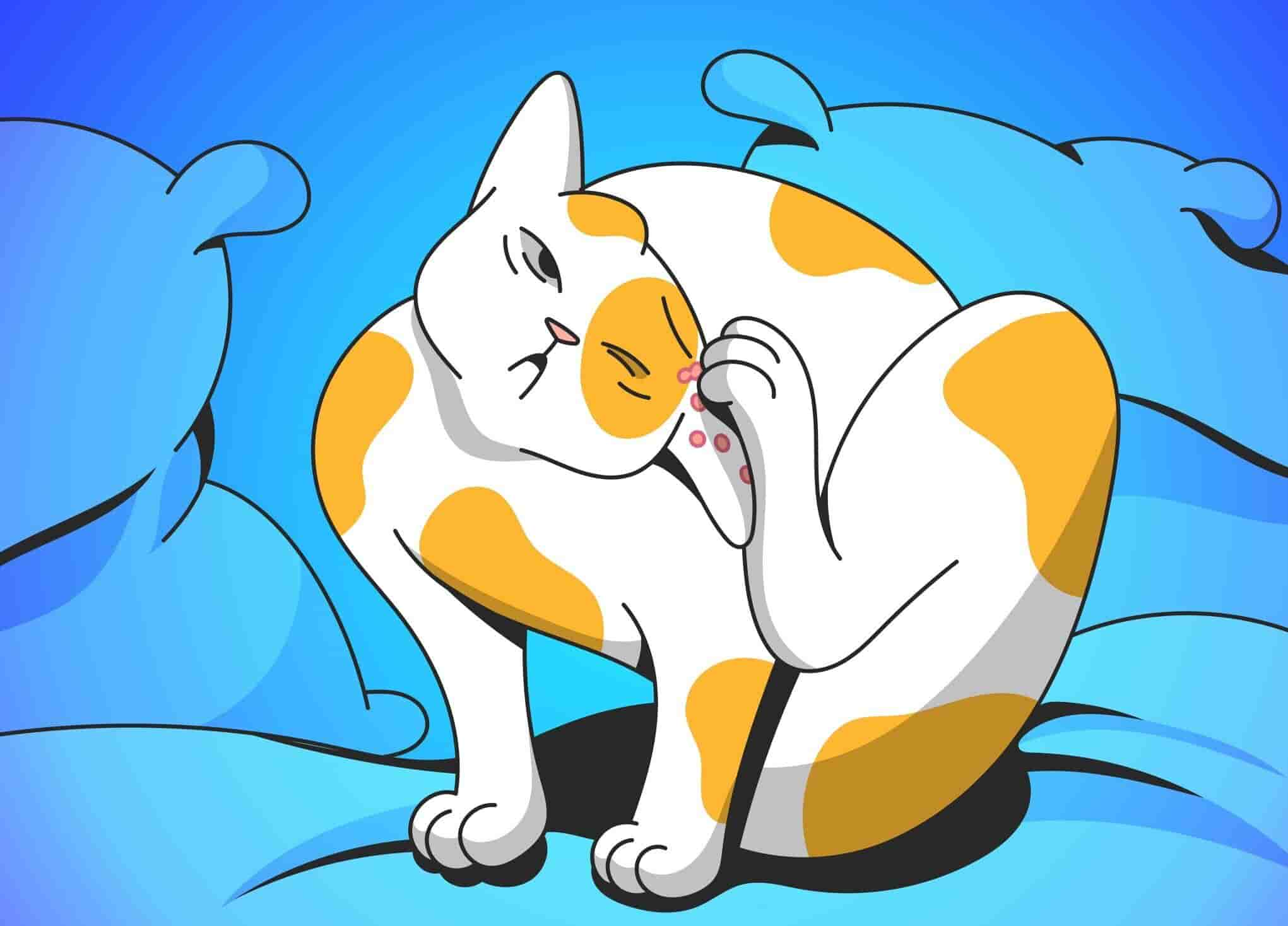Cats are the very epitome of grace and decorum…until that is, they start scratching and twitching from itchy skin. If your cat is obsessively scratching or compulsively grooming more than usual, there's a good chance your poor baby has cat dermatitis.
This article was reviewed by our expert veterinarian, Chris Vanderhoof (DMV).
What is cat dermatitis?
Dermatitis is a general term used to describe inflammation of the skin. This inflammation can be caused by several things and usually results in your cat having to deal with intense itching and discomfort.
Dermatitis appears as clusters of small red bumps or a rash, which, if left untreated and well scratched by your poor suffering feline, become scabs and even bald patches. In severe cases, the rash can become infected, causing pustules.
The symptoms of dermatitis in cats include:
- Continuous scratching and twitching;
- Hair loss;
- Lesions and small bumps on the skin (usually around the back, neck, and head);
- Hair pulling;
- Raw skin from constant scratching;
- Redness and swelling of the skin.
Causes of cat dermatitis
There are many possible causes of feline dermatitis, but the following three are the most common.
Food allergies
Food allergies are a common cause of dermatitis in cats. Usually, this leads to a rash or bumps, particularly on the head and neck area.
The best way to treat this kind of dermatitis in cats is to identify and eliminate the food that is potentially causing the problem.
Fleas
Some cats are particularly sensitive to flea bites which can result in inflammation and dermatitis. This dermatitis will spread throughout the body wherever the fleas have bitten.
An effective flea treatment will be required to eliminate the problem of fleas causing dermatitis.
Environmental factors
Various environmental factors can also contribute to the development of feline dermatitis. Things like inhaled allergens, adverse reactions to medication, ringworm, bacterial infections, hormone problems, and even immune disorders can all cause your cat to develop feline dermatitis.
Unfortunately, identifying the cause and eliminating this can be a lengthy process of trial and error. It's a good idea to work closely with a veterinarian to find a solution.
Types of cat dermatitis and their symptoms
Miliary dermatitis
This is usually a result of an allergy, most commonly to flea bites or something in the cat's diet. The term 'miliary' is derived from the Latin form of 'millet,' so named because crusted lesions resemble millet seeds.
Flea Allergy Dermatitis
Flea dermatitis is an allergy to antigens found in the saliva of fleas. The irritation caused is usually found on the face, neck, and back of affected cats.
Treatment focuses on identifying and removing the allergen from the cat's daily life, which should result in clearing dermatitis. Sometimes corticosteroids and antihistamines may also be prescribed to manage symptoms.
Solar dermatitis
As the name suggests, solar dermatitis is caused by exposure to the sun. It's most common in cats with white or pale patches of skin and usually affects the ears, nose, and sometimes eyelids. Often ear edge dermatitis falls within this category.
Initially, the problem presents as pink, scaly patches with some hair loss but will progress to crusting and ulceration. Without treatment, the disease can sometimes progress to a malignant tumor known as a squamous cell carcinoma.
It's essential to avoid sun exposure by keeping your cat indoors between 10 am and 4 pm on sunny days if you wish to prevent this kind of dermatitis.
Also, cats should be discouraged from lying in the sun inside the house. Feline sunscreen is available, although this is most often licked off. Because of this, it's inappropriate to use human sunscreen on a cat as some of the ingredients may be toxic to cats.
Besides, you can always check what your furry fella is doing at home with the help of Petcube's interactive cat camera. Petcube aids you to be in touch with your cat kid and have the recorded history of their time when you are away from home.
Atopic dermatitis
According to research, atopic dermatitis is caused by an allergy to inhaled substances (pollen, dust), ingested allergens, and allergens directly contacting the skin. This causes itching of the skin, which can be localized or over the entire body. Commonly, the feet, face, ears, and armpits are affected.
Food allergies can be controlled by limiting your cat's exposure to the allergen. Unfortunately, airborne allergens are harder to control, so medication will likely be required to manage symptoms; this includes steroids, anti-inflammatories, and antihistamines.
Seborrheic dermatitis
Seborrhea or seborrheic dermatitis is caused when the sebaceous glands of the skin over-produce sebum. This results in scaly, flaky, and itchy skin. Typically, the areas most affected are the back, face, and sides, particularly where skin folds.
The causes of seborrhea include hormonal imbalances, allergies, fungal infections, obesity, and parasites. This underlying cause will determine the correct treatment. Treatments usually include steroids, specially medicated shampoos, dietary supplements (Omega-3 fatty acids), and sometimes antibiotics (where bacterial infections are present).
Eosinophilic dermatitis
Feline eosinophilic granuloma is a skin allergy that can cause severe skin problems in cats. The trigger may be something present in your cat's environment, like fleas, dust, food, or mites.
This severe allergy causes blood cells known as eosinophils to gather on the skin. This can present in three ways:
- Rodent ulcers – also known as indolent ulcers. These are raised patches of skin, usually on the upper lip and roof of the mouth.
- Eosinophilic plaques – are round areas of thickened skin that are red, hairless, painful, and very itchy. These can develop anywhere but most commonly are found on the face, neck, inner thighs, and tummy.
- Eosinophilic granulomas – are thin, elongated patches of itchy skin. They are usually swollen and weepy and found on the paws, chin, and inside the mouth.
Treatment includes eliminating the allergen responsible, anti-inflammatories, and antibiotics. In severe cases, surgery may be required to remove skin that refuses to heal.
Malassezia dermatitis
Your cat's skin has a yeast known as Malassezia pachydermatis. Abnormal overgrowth of this yeast can cause dermatitis in felines and skin irritation. In addition to becoming red and irritated, the skin may appear greasy or scaly. Thickening and darkening of the skin are not uncommon, as is a foul-smelling odor from the lesions.
Treatment focuses on reducing the number of yeast and bacteria on your cat's skin using medicated ointments and shampoos. Antibiotics may also be used when there is a simultaneous bacterial infection.
Cat dermatitis treatment
Because so many things can cause dermatitis, there's no simple answer to this question. The approach you choose will depend on various factors but usually include avoiding triggers where possible.
Read more: Cat Skin & Dental Care Secrets
After that, treatment may consist of antibiotics, antihistamines, dietary changes, dietary supplements, and medicated baths and ointments.
Help is at hand with Online Vet
During those times when you suspect something is up with your cat, it sure would help if you had someone you could turn to for advice. Rushing off to the vet in an emergency is one thing, but what about those times when you just need advice?
The good news is that with Petcube's Online Vet, you'll instantly have a team of trained veterinarians available to you via your phone.
Whenever you have a concern regarding the health and wellbeing of your pet, send a quick text message, attach a photo or video, and get an instant reply – all for just $20 a month.
With the Online Vet service, you can cut unnecessary vet visits, saving you money. It will also protect your darling companion from the trauma of a vet visit that maybe wasn't necessary at all.
For just $9 more, you can add an emergency fund which will pay out the value of $3000 annually for emergency vet care. In an emergency, the last thing you want is to make a decision for your pet's well-being based on your financial situation. An emergency fund will give you peace of mind that your pet will get the care it needs in an emergency.
FAQ
How to tell if my cat has dermatitis?
Cat dermatitis symptoms include:
- Persistent itching and scratching;
- Noticeable hair loss;
- Redness and swelling of the skin;
- Patches of bumps on the skin;
- Raw skin and scabs from scratching.
Is miliary dermatitis in cats treatable?
Yes. Miliary dermatitis in cats can be treated depending on the cause. Your vet can prescribe medication if it's a food allergy, fleas, mange, or environmental allergen.
Is cat dermatitis contagious?
Most dermatitis is not contagious to humans or other pets. However, if the cause of the dermatitis is fungal, bacterial, or due to parasites, there is a possibility that it may be passed on to people and pets.
Can I use coconut oil for cat dermatitis?
One of the more effective home remedies for miliary dermatitis is coconut oil. It can be rubbed into your cat's skin to relieve the itching. Generally, coconut oil can help with overall skin and coat health.
Start with a small amount first to see how your cat reacts. Chat to your vet about how much to use – too much can cause other problems.
How to soothe flea allergy dermatitis in cats?
The allergic reaction to flea bites can cause intense itching. The best way to relieve this is by using a corticosteroid. But there are some natural ways to offer some relief. Bathing your cat in lukewarm water or mild oatmeal shampoo can help. If your cat has ulcers or scratches on their skin, it's best to avoid washing them.

Was this article helpful?
Help us make our articles even better










